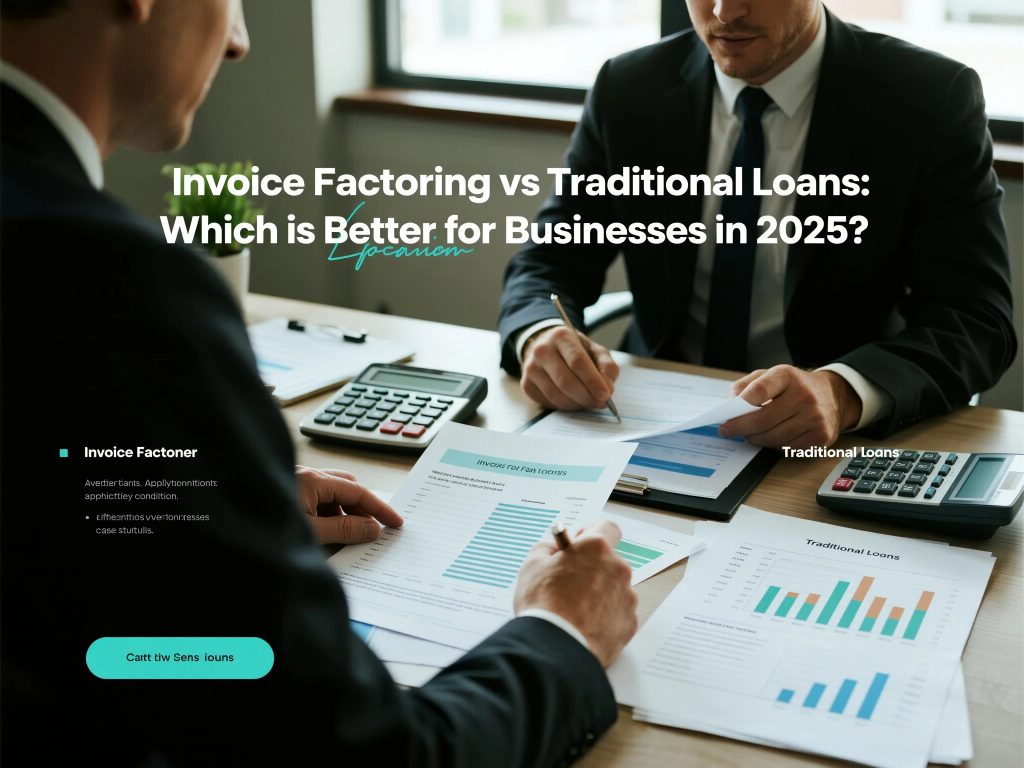The Fundamental Differences: Invoice Factoring Versus Traditional Business Financing In the evolving landscape of business financing, companies face critical decisions when selecting the most appropriate funding solutions to support their growth objectives. The choice between invoice factoring companies usa and conventional lending institutions
represents more than just a financial transaction—it embodies a strategic approach to cash flow management and business development. Traditional business loans have long served as the cornerstone of corporate financing, offering structured repayment terms and potentially lower interest rates for qualified borrowers. However, the stringent qualification requirements, lengthy approval processes, and collateral demands often create significant barriers for small and medium-sized enterprises seeking immediate capital infusion. This fundamental mismatch between traditional lending practices and the dynamic needs of modern businesses has catalyzed the rapid growth of alternative financing options that prioritize flexibility, speed, and accessibility over conventional metrics of creditworthiness.The operational mechanics of invoice factoring distinguish it fundamentally from traditional loan structures, creating unique advantages and considerations for business owners. Rather than extending credit based on historical financial performance or asset collateral, factoring companies purchase outstanding invoices at a discount,
providing immediate cash flow based on accounts receivable quality. This approach transforms unpaid customer obligations into working capital, enabling businesses to maintain operations, pursue growth opportunities, and navigate seasonal fluctuations without accumulating debt on their balance sheets. The evaluation criteria focus predominantly on customer creditworthiness rather than business financials, making this solution particularly valuable for companies with strong sales but limited operating history or collateral assets. The factoring relationship typically involves ongoing collaboration, with providers offering credit management services and assuming collection responsibilities, thereby reducing administrative burdens for client businesses while ensuring professional accounts receivable management.Accelerated Cash Flow Solutions: The Rise of Fast Invoice Factoring
The contemporary business environment demands rapid financial decision-making and immediate access to capital, driving increased adoption of fast invoice factoring services across diverse industry sectors. This financing mechanism addresses the critical timing gap between service delivery or product shipment and customer payment, which often stretches to 30, 60, or even 90 days in many B2B relationships. The acceleration of cash conversion cycles through factoring enables businesses to optimize working capital management, reduce reliance on expensive short-term borrowing, and maintain financial stability during growth phases or market uncertainties. The technological advancements in financial technology have revolutionized the factoring industry, with digital platforms now offering streamlined application processes, automated credit decisions, and same-day funding capabilities that dramatically outperform traditional banking timelines. This efficiency transformation has made invoice factoring increasingly accessible to businesses of all sizes, from emerging startups to established corporations seeking to enhance their financial agility.
The implementation of fast invoice factoring involves a structured yet efficient process that begins with comprehensive due diligence and establishes an ongoing funding relationship. Businesses typically submit their accounts receivable for evaluation, with factors assessing customer credit quality, invoice authenticity, and payment history to determine advance rates and fee structures. Upon approval, companies receive immediate funding—often within 24 hours—for a significant portion of their invoice value, typically ranging from 70% to 90% depending on industry standards and risk assessment. The remaining balance, minus factoring fees, is released upon customer payment, creating a predictable cash flow pattern that supports operational planning and strategic investment. The fee structure generally comprises a discount fee based on the invoice value and the time outstanding, plus additional service charges for credit management and collection services. This transparent pricing model allows businesses to accurately calculate financing costs and compare them against the opportunity costs of delayed cash availability or alternative funding sources.
Asset-Based Lending Frameworks: Collateralized Financing Solutions
The realm of asset-based lending firms offers sophisticated financing solutions that leverage company assets as collateral to secure working capital facilities. This approach represents a middle ground between traditional bank loans and pure invoice factoring, providing businesses with flexible credit lines based on the value of their accounts receivable, inventory, equipment, and other balance sheet assets. Asset-based lending arrangements typically involve comprehensive collateral audits, ongoing monitoring of asset values, and regular borrowing base certifications to ensure adequate security coverage for the extended credit. The structured nature of these facilities appeals to businesses with substantial tangible assets seeking larger financing amounts, longer terms, and more predictable repayment structures than those available through conventional factoring arrangements. The lending criteria focus extensively on collateral quality and liquidity, with lenders establishing advance rates against different asset categories based on their realizable value in liquidation scenarios.
The operational dynamics of asset-based lending involve continuous collaboration between borrowers and lenders to maintain appropriate collateral margins and compliance with financial covenants. Businesses typically receive revolving credit facilities based on predefined percentages of eligible accounts receivable and inventory, with regular reporting requirements and field examination procedures to verify asset values and quality. The lending structure provides flexibility for seasonal fluctuations and growth initiatives, allowing companies to borrow against their asset base as needed rather than receiving lump-sum disbursements. The cost structure generally includes interest charges based on outstanding balances, plus additional fees for collateral monitoring, auditing, and administrative services. This comprehensive approach to secured lending enables businesses to maximize their borrowing capacity while maintaining operational flexibility, though it requires robust financial controls and transparent reporting systems to satisfy lender requirements. The relationship often extends beyond mere financing to include strategic advice on working capital optimization, inventory management, and accounts receivable processes that enhance overall financial performance.

Merchant Cash Advance Considerations: Revenue-Based Financing Alternatives
The landscape of alternative business financing includes merchant cash advance companies that provide capital based on future revenue projections rather than historical financial performance or asset collateral. This funding mechanism appeals particularly to retail and service businesses with consistent credit card sales volumes but limited physical assets or established credit histories. Merchant cash advances involve the purchase of future receivables at a discount, with repayment structured as a percentage of daily credit card transactions or bank deposits. This variable repayment approach aligns with business cash flow patterns, reducing the fixed payment obligations that can strain operations during seasonal downturns or unexpected challenges. The application process typically emphasizes recent sales performance rather than traditional credit metrics, making these advances accessible to businesses that might not qualify for conventional bank financing due to short operating histories, irregular revenue patterns, or previous credit issues.
The structural characteristics of merchant cash advances create distinct advantages and considerations for business owners evaluating this financing option. The funding process typically involves minimal documentation requirements and rapid approval decisions, often within hours or days rather than the weeks required for traditional loan applications. This speed and accessibility come at a cost, however, with effective annual percentage rates generally higher than those associated with conventional business loans or asset-based lending facilities. The repayment mechanism automatically deducts a fixed percentage of daily credit card sales or bank deposits, creating a self-adjusting payment schedule that correlates with business performance. This feature provides protection against cash flow crunches during slow periods but extends the repayment timeline during prosperous periods. The cost structure usually involves factor rates rather than interest rates, with the total repayment amount calculated as a multiple of the advanced capital. This pricing model requires careful evaluation against the time value of money and alternative financing costs to determine the true economic impact on business operations and profitability.
Small Business Working Capital Strategies: Comprehensive Financing Approaches
The strategic management of small business working capital loans represents a critical component of sustainable business growth and financial stability. Working capital financing addresses the fundamental challenge of timing mismatches between cash outflows for operational expenses and cash inflows from customer payments, enabling businesses to maintain smooth operations while pursuing expansion opportunities. Traditional working capital loans provide lump-sum funding with fixed repayment terms, offering predictability for financial planning but potentially creating cash flow pressure during business downturns. Alternative solutions, including lines of credit, invoice financing, and revenue-based advances, offer more flexible approaches that align with business cycles and revenue patterns. The selection among these options requires careful analysis of cost structures, repayment flexibility, funding speed, and impact on financial statements to determine the optimal solution for specific business circumstances and strategic objectives.
The implementation of effective working capital management strategies involves comprehensive assessment of operational cycles, cash conversion efficiency, and financing alternatives. Businesses must evaluate their accounts receivable collection periods, inventory turnover rates, and accounts payment terms to identify opportunities for working capital optimization before seeking external financing. The integration of technology solutions for invoicing, collections, and payment processing can significantly enhance cash flow management and reduce reliance on expensive external funding. When external capital becomes necessary, businesses should compare the total cost of capital across different financing options, considering not only interest rates and fees but also opportunity costs, administrative burdens, and strategic flexibility. The optimal working capital solution often involves a blended approach, combining traditional term loans for stable, predictable needs with flexible facilities like lines of credit or invoice financing for seasonal fluctuations or unexpected opportunities. This comprehensive perspective on working capital management enables businesses to maintain financial health while positioning themselves for sustainable growth and competitive advantage in their respective markets.
Strategic Decision-Making: Selecting the Optimal Financing Solution
The complex landscape of business financing options demands strategic analysis and informed decision-making to align funding solutions with specific business objectives, financial circumstances, and growth trajectories. The evaluation process should encompass quantitative factors including cost of capital, funding amount requirements, repayment terms, and cash flow impact, alongside qualitative considerations such as lender relationships, administrative requirements, and strategic flexibility. Businesses must assess their tolerance for debt, capacity for regular repayments, and need for financial agility when comparing traditional loans against alternative financing options. The decision often involves trade-offs between cost efficiency and accessibility, with traditional bank loans typically offering lower rates for qualified borrowers but requiring stronger financial credentials and longer approval timelines. Alternative solutions provide faster access to capital with more flexible qualification criteria but generally involve higher costs and potentially more complex fee structures.
The implementation of chosen financing solutions requires meticulous planning and ongoing management to maximize benefits while minimizing risks and costs. Businesses should establish clear objectives for capital utilization, performance metrics for evaluating financing effectiveness, and contingency plans for unexpected challenges. The relationship with financing providers should extend beyond transactional interactions to strategic partnerships that provide valuable insights, industry expertise, and potential opportunities for additional support. Regular reviews of financing arrangements ensure they continue to align with evolving business needs and market conditions, enabling timely adjustments or refinancing when advantageous. The integration of technology platforms for financial management, reporting, and communication enhances transparency, efficiency, and decision-making capabilities throughout the financing lifecycle. This comprehensive approach to financing strategy enables businesses to leverage external capital effectively while maintaining financial stability, operational flexibility, and competitive positioning in dynamic market environments.
Future Trends: The Evolution of Business Financing in 2025 and Beyond
The business financing landscape continues to evolve rapidly, driven by technological innovation, regulatory changes, and shifting market dynamics that create new opportunities and challenges for companies seeking capital. The integration of artificial intelligence and machine learning into credit decisioning processes enables more sophisticated risk assessment, personalized pricing, and faster funding approvals across various financing options. Blockchain technology and smart contracts promise enhanced transparency, security, and efficiency in financing transactions, potentially reducing costs and administrative burdens for both borrowers and lenders. The growing emphasis on environmental, social, and governance (ESG) considerations influences financing decisions, with lenders increasingly incorporating sustainability metrics into their evaluation criteria and offering preferential terms for businesses demonstrating strong ESG performance. These trends collectively contribute to a more diverse, accessible, and efficient financing ecosystem that better serves the diverse needs of modern businesses across different industries, growth stages, and market conditions.
The future trajectory of business financing will likely feature increased specialization and customization of solutions tailored to specific industry requirements, business models, and growth objectives. The convergence of traditional and alternative financing approaches creates hybrid solutions that combine the stability and cost efficiency of bank lending with the flexibility and accessibility of fintech innovations. The regulatory environment continues to adapt to technological advancements and market developments, balancing consumer protection with innovation facilitation to ensure a stable yet dynamic financing ecosystem. The globalization of capital markets and the emergence of cross-border financing platforms provide businesses with access to diverse funding sources beyond their domestic markets, creating opportunities for competitive financing terms and strategic partnerships. These evolutionary trends empower businesses to make more informed financing decisions, optimize their capital structures, and leverage external funding to achieve sustainable growth and competitive advantage in an increasingly complex and interconnected global economy.




